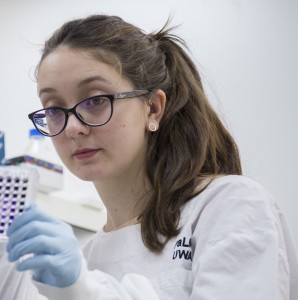Taking up the AMR fight

By Miss Emily Kibble, PhD Candidate at Murdoch University
My PhD researches the bacterium Neisseria meningitidis. This bacterium causes the fatal invasive meningococcal disease (IMD) which manifests as an infection of the blood or infection of the lining of the brain. One in ten adults are known to carry this bacterium in their throat at any given time. Transmission from human to human occurs through close contact, therefore infection rates are higher in close living quarters, such as military barracks. Once this bacterium spreads to a susceptible person, symptoms begin within a matter of hours, and death can quickly follow (in almost half of all cases). One in five survivors will suffer from disabilities such as limb loss and brain damage. Even with an existing vaccine, the rates of IMD in Australia are scarily on the rise, with 2017 seeing the highest rates of disease in ten years. As this bacterium is becoming increasingly resistant to current antibiotic treatments, looking into different approaches to overcome antimicrobial resistance (AMR) is essential.

My research investigates the impact of targeting a group of proteins, known as macrophage infectivity potentiator (Mip) proteins. When Mip proteins are inhibited, the ability of N. meningitidis to cause disease is suppressed. Therefore, a medical countermeasure (MCM) which targets Mip proteins should
• disarm the bacteria,
• interfere with the progression of disease, and, potentially,
• allow previously ineffective antibiotics to be used again.
These Mip proteins expressed by N. meningitidis are also expressed by a range of disease-causing bacteria, such as the biothreat agents, Coxiella burnetii, which causes Q fever, and Burkholderia pseudomallei which causes melioidosis. The potential of a new broad-spectrum treatment led to the current DMTC collaborative project headed by the University of Western Australia with Defence Science and Technology (DST) Group, the Peter Doherty Institute and the University of Wurzburg. It centres on targeting these Mip proteins and encompasses a range of bacteria which are of concern to both the Australian Defence Force and public health authorities, with the aim to develop a new MCM that can be used against a number of bacterial diseases.
A pathogen does not care if you are wearing a uniform or not
The overlap of risk to Defence and public health is due to the fact that bacteria do not discriminate, and nor does AMR. Any person, Defence personnel or otherwise, can become infected, and these infections are becoming harder to kill.
AMR is the ability of a bacteria to resist treatment. Using antibiotics when they are not necessary, or not completing your prescribed course of antibiotics, give bacteria the opportunity to mutate and become resistant. By 2050, the rates of AMR bacteria will have risen to such high numbers that a predicted 10 million deaths will occur each year across the globe. Resistant bacteria will make some infections impossible to treat, and make minor injuries and medical procedures life threatening.
The population of Australia will particularly suffer, as the use of antibiotics – the main cause of AMR – is higher in Australia than most other countries in the world. While the threat posed to Australia is increasing, most new drugs are modifications of previously existing antibiotics, and can only be relied on as short-term solutions. Investment and support from commercial drug makers for the development of truly novel MCMs is inconsistent. This is due largely to the small market that could constrain the return on investment, long lead times and lack of certainty of success in drug development pipelines, as well as the restrictions on future development imposed by governments.
Australia’s Department of Health has acknowledged that increased support is required for the research and development of new approaches and products to combat AMR.
More effective, long-term, medical countermeasures against AMR are becoming an increasingly urgent national requirement. Enhanced capability to combat bacterial infections, particularly as these infections become resistant to the current available treatments, is vital for the future health of the Australian population as well as better-equipped and protected Defence forces.
Posted by Emily Kibble on February 7th, 2020 Tagged: AMR, Defence health, DMTC, Emily Kibble, IMD, Mip, Neisseria meningitidis, UWA